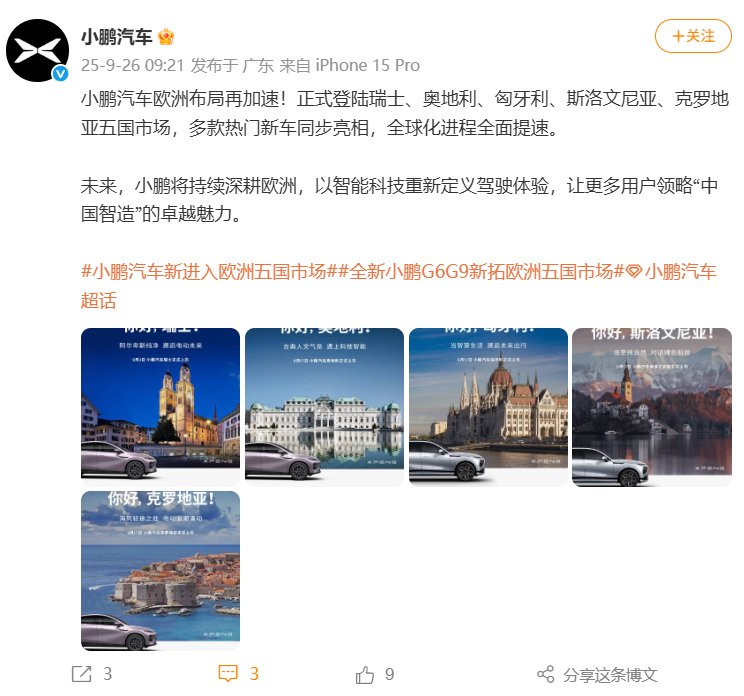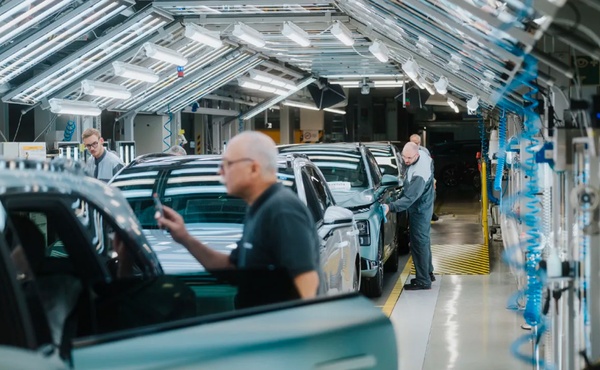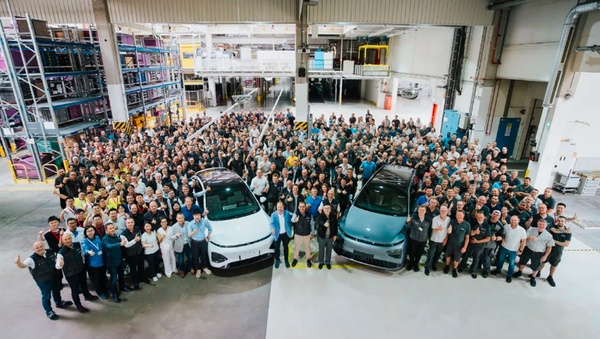Xpeng's "Triple Attack" in Europe! Supply Chain Expansion Overseas: What Can Plastic Companies Learn?
Specialized Viewpoint Observed on the 27th, Since September,Xpeng Motors"Triple strike" posture accelerates European layout: On the 16th, local production at the Magna plant in Graz, Austria officially began, and on the 26th, it announced entry into Switzerland and four other markets, while simultaneously advancing technology adaptation at the Munich R&D center.
This series of actions marks the rise of new Chinese automotive enterprises.The strategic upgrade from "trade going abroad" to "ecosystem going abroad" has provided a breakthrough path for Chinese automotive industry chain enterprises to "exchange space for time" under the pressure of EU anti-subsidy taxes.

Tariff barriers force localization of production: Xiaopeng Magna Breakthrough
Facing the European UnionIn 2024, China will impose an anti-subsidy tax of 17.0%-36.3% on electric vehicles. Xiaopeng Motors has chosen to collaborate with the Magna Graz plant, which has a century-long history of high-end manufacturing, to achieve cost restructuring through "contract manufacturing." This plant has previously produced classic models such as the Mercedes-Benz G-Class and BMW Z4, with an annual capacity of 200,000 units and flexible production lines supporting multi-model production. Although Xiaopeng needs to pay a contract manufacturing fee of 20.7%, the overall cost is reduced by 15%-20% compared to the completely imported vehicle model, successfully avoiding tariff barriers.
The "asset-light + strong synergy" model has proven effective: In the first seven months of 2025, XPeng's overseas sales reached 18,700 vehicles, a year-on-year increase of 217%. The European market contributed over 8,000 vehicles, with the G6 model accounting for 67%, becoming the absolute mainstay. The Munich R&D center has been simultaneously put into operation, focusing on the localization adaptation of intelligent driving, and has achieved deep matching of L2-level functions with European road conditions. In the future, it will expand to categories such as sedans and high-performance electric vehicles.
New forces going abroad, "Product Output" to "Ecosystem Building"
The case of Xpeng reflects the overall strategic upgrade of Chinese car manufacturers going overseas. Traditional car manufacturers like Chery have continuously...Having been the export champion for 22 consecutive years, it exported 444,000 vehicles in the first five months of 2025. Meanwhile, BYD has adopted a dual strategy of "fleet + factory" by establishing factories in Brazil, Hungary, and other locations, with overseas sales surpassing 470,000 vehicles in the first half of 2025. New players are increasingly highlighting their technological export features—Leapmotor, in partnership with Stellantis, has established Leapmotor International to rapidly cover nine European countries. NIO maintains a high-end positioning, expanding its market in countries like Portugal and Greece through a national distributor model.

Range: XPeng
Model innovation is concentrated in three dimensions: firstly, establishing factories overseas to achieve localized production, such as BYD's factory in Hungary.In 2025, production will commence with a designed annual capacity of 150,000 vehicles. Secondly, technical collaboration is facilitating localized R&D, with XPeng's Munich center already working on the adaptation of cutting-edge technologies such as intelligent cockpits and LiDAR. Thirdly, supply chain collaboration is achieving ecological localization, with CATL establishing battery bases in Germany and Hungary, forming a complete "battery-vehicle-charging network" ecosystem. This reduces procurement costs for European customers by 20% and shortens the delivery cycle to 7 days. This shift from "product export" to "capacity output + ecosystem construction" has driven the Net Promoter Score (NPS) of Chinese car companies overseas to 81%, surpassing several traditional luxury brands.
Supply chain expansion overseasFor plastic companies
The globalization of supply chains is driving three major transformation trends, which have direct implications for plastic companies.
The rise of circular supply chain models
H&M's recycling program serves as an example, with the utilization rate of regenerated fibers from clothing reaching 30%. In the automotive industry, the recycling of plastic products has become a key breakthrough point. XPeng's European factory plans to introduce more local suppliers in the future, forming a "China R&D + Europe Manufacturing + Global Sales" closed loop. According to a report by Rhodium Group, in 2024, overseas investment in China's new energy vehicle industry chain will reach 16 billion USD, surpassing domestic investment for the first time, with the battery sector accounting for 74%. This reversal in capital allocation is driving plastic companies to transform into "circular material suppliers," such as by developing recyclable polycarbonate and bio-based engineering plastics, to meet EU circular economy regulation requirements.
Digitization of supply chain====
Amazon PassAI algorithm achieves a 40% improvement in order processing efficiency, providing a model for the automotive supply chain. Plastic companies need to build a digital platform to achieve full-process visibility from raw material procurement, production scheduling, to logistics distribution. For example, Minth Group can learn from Magna's flexible production experience to develop an intelligent scheduling system that supports rapid switching of plastic parts for multiple models; Changshu Automotive Trim can introduce blockchain technology to achieve raw material traceability and enhance ESG compliance.

Source: XPeng
Elastic supply chain becomes standard.
Toyota reduces supply chain disruption risks through a multi-supplier system.30% of practices are universally applicable in the automotive industry. Plastic companies need to build a "dual circulation" supply chain: on one hand, maintaining a scale advantage in China to serve domestic new energy vehicle companies; on the other hand, establishing regional supply centers in overseas markets such as Europe to shorten delivery cycles. For example, building a modified plastic factory in Hungary to serve Chinese car companies like Xpeng and BYD locally, while also covering the Central and Eastern European market.
Future Outlook: FromThe Transformation Path from "Made in China" to "Intelligent Manufacturing Globally"
XPeng Motors has started production in Europe, marking the beginning of Chinese car manufacturers'...The strategic leap from "trade going overseas" to "ecosystem going overseas." Driven by both tariff evasion and cost optimization, achieving localized production with global tier-one supplier resources may become the new norm in the industry. With supporting enterprises like CATL's German factory and SVOLT's German base going overseas, the future can realize local supply of core components such as batteries, forming a network structure of "R&D in China, production locally, and a globalized supply chain," which is expected to optimize the comprehensive cost of Chinese OEMs by 10%-15%.
According to the China Passenger Car Association's forecast,By 2025, China's export volume of new energy vehicles is expected to exceed 2 million units, with a global market share likely to reach 25%, ultimately building a more solid moat in international market competition. This transformation will not only reshape the global automotive industry landscape but also provide crucial support for global green and low-carbon transitions. For plastic companies, seizing the trends of circular economy, digital transformation, and flexible supply will enable them to gain an advantage in this historic opportunity, achieving a magnificent transformation from "supporting supplier" to "ecosystem partner."
Xpeng's story in Europe is not only a microcosm of the new forces going abroad but also the prologue to the reshaping of the global competitiveness of China's industrial chain. In this silent industrial revolution, every innovation in each segment is writing a new chapter.The new chapter of "Made in China with Intelligence".
【Copyright and Disclaimer】This article is the property of PlastMatch. For business cooperation, media interviews, article reprints, or suggestions, please call the PlastMatch customer service hotline at +86-18030158354 or via email at service@zhuansushijie.com. The information and data provided by PlastMatch are for reference only and do not constitute direct advice for client decision-making. Any decisions made by clients based on such information and data, and all resulting direct or indirect losses and legal consequences, shall be borne by the clients themselves and are unrelated to PlastMatch. Unauthorized reprinting is strictly prohibited.
Most Popular
-

Zf asia-pacific innovation day: Multiple Cutting-Edge Technologies Launch, Leading Intelligent Electric Mobility
-

Mexico officially imposes tariffs on 1,400 chinese products, with rates up to 50%
-

Fire at Sinopec Quanzhou Petrochemical Company: 7 Injured
-

List Released! Mexico Announces 50% Tariff On 1,371 China Product Categories
-

Argentina Terminates Anti-Dumping Duties on Chinese PVC Profiles! Kingfa Technology & Siemens Sign Digital and Low-Carbon Cooperation Agreement






